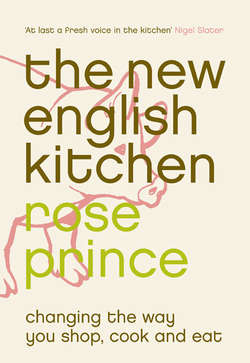Читать книгу The New English Kitchen: Changing the Way You Shop, Cook and Eat - Rose Prince - Страница 7
1 bread and flour
ОглавлениеBread can pull off a feat that few cooked foods are capable of: as it matures, it develops new and interesting uses. In other words, it ages gracefully. Once past its sandwich era, older bread fits easily into simple recipes: it lies beneath radiant vegetable broths, turns up in a bread, red wine and onion soup, blends smoothly into a clove-infused sauce, and can be sweetly saturated by a creamy, eggy custard with spices and fruit. There’s always toast, too, an edible plate for favourite things. The bread that can do all this is not sliced and wrapped, sometimes costing little more than a first-class stamp, but made in the slower tradition. This bread has real integrity but it costs a bit more – which is why it is worth knowing how to use it as it ages.
The life of a good loaf of bread could unfold in the following way. On day one, it is as fresh as can be, the interior deliciously elastic and the crust crisp as an eggshell. A day or two later the crumb begins to dry, the crust to soften, and it’s good for toast. Toast brushed with flavoured oil, then topped with salad leaves and soft fresh cheese; toast with creamy scrambled egg and marinated fish; or, best of all, toast spread with real beef dripping from yesterday’s roast. Next day, put a slice of the now drying bread into a bowl and ladle over some vegetable broth. Or, if you are having a supper party, you might use the bread to make a toffee pudding or a fruit charlotte. By the end of the week, anything left from the loaf can be made into breadcrumbs. Eat them spiked with lemon zest beside roast poultry or game; mix them with garlic, herbs and olive oil for stuffing vegetables; or store them in the freezer for bread sauce. By now, I think it would be safe to say your loaf has earned its keep. You bought it to make a sandwich and it has contributed to at least four meals.
The economics of bread have an interesting pattern. A loaf of sliced, wrapped bread costs about 50 pence – although supermarket price wars have seen it drop down to 20 pence as a ‘loss leader’. Better-grade, high-street-baked sliced white costs about £1. Handmade traditional bread is twice that, at around £2, but a loaf made at home with best-quality flour costs about 50 pence – again.
This leaves two choices: buy better, more expensive bread and learn how to reap more from it – as the recipes in this chapter will show – or bake bread at home and spend no more than usual. Obviously there’s yet more to gain from baking your own bread and letting it earn its keep as it ages. I look at it this way: the time investment made when baking bread at home rewards you financially, leaving you more money to spend on other things. Having said that, it occurs to me that it is in fact quicker to make good bread than to go off and seek it out. Bread machines have made it easier still for busy people. But, putting the economics to one side, you can take real satisfaction in the fact that the bread you make in your own home will be the best. Unadulterated, wholesome bread is something of an endangered species nowadays …
